9 Web3 Marketing Automation Best Practices to Scale in 2025
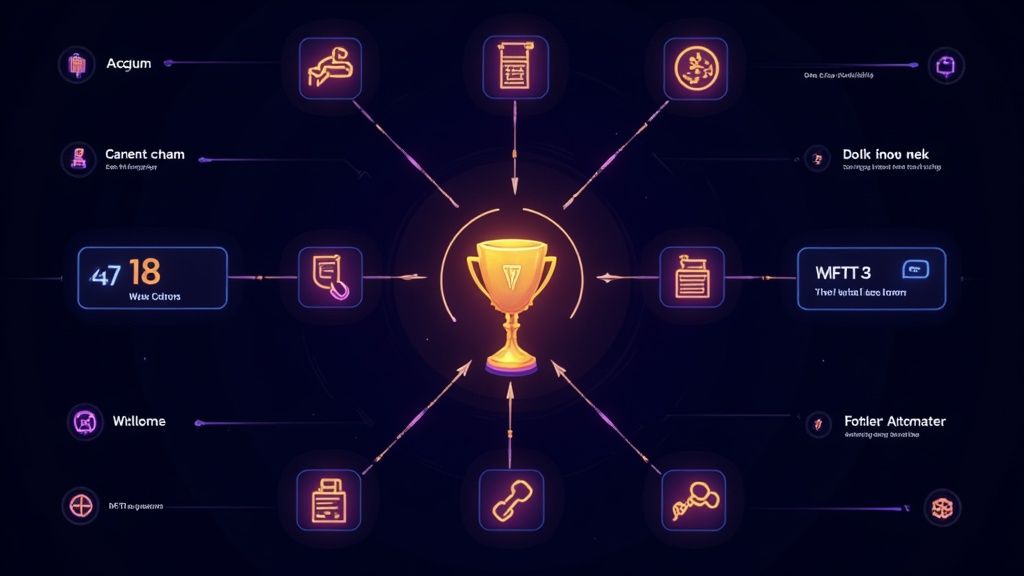
In the fast-paced world of Web3, manual marketing just doesn’t cut it. You're juggling community engagement, user acquisition, and on-chain activities, all while trying to build momentum. The secret weapon? Smart automation.
This guide isn't about generic tips; it's a deep dive into actionable marketing automation best practices specifically for designing and scaling reward-based quests. We'll explore how to move beyond simple airdrops to create sustainable engagement loops that turn passive followers into active contributors. Think of it as your playbook for building a self-sustaining growth engine.
We’ll show you how to streamline these complex processes, letting you build sophisticated, multi-step quests that combine on-chain and off-chain actions. This means less manual work and more time spent on strategy. Get ready to learn the specific tactics that leading Web3 projects use to boost acquisition, deepen engagement, and build vibrant, loyal communities. From intelligent lead scoring and multi-channel campaign integration to precise ROI measurement, we're covering the essential frameworks you need to put your Web3 growth on autopilot and achieve measurable results. Let's dive in.
1. Lead Scoring and Segmentation
Stop shouting into the void and start talking to the right people at the right time. That's the core idea behind lead scoring and segmentation, a cornerstone of effective marketing automation best practices. Instead of treating your entire audience as one big monolith, you assign points to leads based on who they are (demographics) and what they do (engagement). This helps you pinpoint who’s ready for a sales chat and who needs more nurturing.
Segmentation then takes these scored leads and groups them based on shared traits. Think of it like sorting your NFT collection: you have your high-value 1-of-1s (hot leads), your floor-price PFPs (warm leads), and your airdrop spam (cold leads). This lets you tailor your automated quests and rewards, sending hyper-relevant messages that actually resonate.
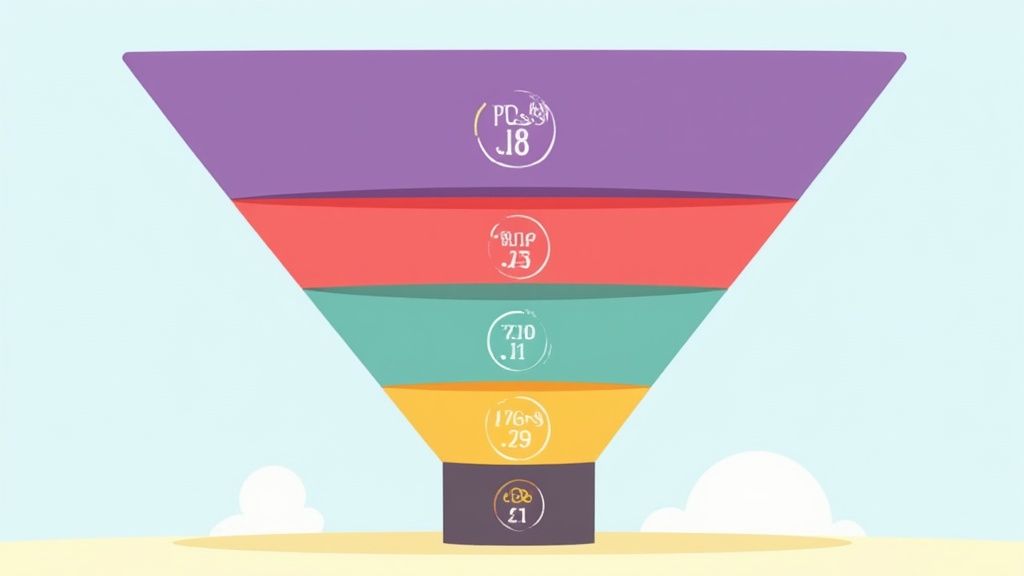
Why It Works and How to Implement It
This dynamic duo helps you focus your resources where they’ll have the biggest impact, boosting conversion rates and preventing your sales team from wasting time on unqualified prospects. For instance, Marketo’s segmentation tools famously helped Lenovo increase conversions by a massive 30% by delivering more personalized content.
Ready to get started?
- Start Simple: Begin with a basic scoring model. Assign points for key actions like joining your Discord (+5), completing a "Welcome" quest (+10), or visiting your pricing page (+15).
- Use Negative Scoring: Not all actions are positive. A lead from a competitor's domain or someone who unsubscribes should get negative points to filter them out.
- Align with Sales: Your definition of a "hot lead" must match your sales team's. Regularly sync up to refine scoring criteria based on which leads are actually converting.
- Test Your Segments: Create segments for different user personas like "DeFi Degens," "NFT Collectors," or "Web3 Developers." Then, test which quest types resonate most with each group.
Platforms like HubSpot have pioneered this space, making it easy to track hundreds of behavioral signals automatically. If you're looking to dive deeper, you can learn more about lead scoring with HubSpot's tools to see how they integrate these concepts.
2. Drip Campaign Optimization
Drip campaigns are your secret weapon for turning casual interest into dedicated community members. Think of them as an automated conversation, delivering a pre-written sequence of messages over time. Instead of blasting everyone with the same "join now" message, you guide them through a journey, offering value at each step and nurturing them from curious visitor to loyal advocate.
This automated nurturing process is one of the most powerful marketing automation best practices because it works tirelessly in the background. It’s like having a community manager who never sleeps, sending perfectly timed educational content, quest invites, and onboarding tips to keep new users engaged and moving forward.
Why It Works and How to Implement It
Optimized drip campaigns meet users where they are, building trust and momentum. For instance, Grammarly’s educational email series boasts a massive 60%+ open rate by providing genuine value, while Airbnb’s onboarding drip campaign famously increased host activation by 25%. These sequences work by delivering the right information at the right time, preventing overwhelm and encouraging action.
Ready to build your own high-impact drip campaigns?
- Map to the User Journey: Design your campaigns around key stages. A new Discord member needs a "Welcome" sequence, while an inactive user might get a "Re-engagement" quest series.
- Use Behavioral Triggers: Don't just rely on time delays. Trigger messages based on actions. Did a user just complete their first quest? Send a congratulatory message with a hint for the next one.
- Keep it Simple: Each message should have one clear call-to-action (CTA). Are you asking them to join a Twitter Space, complete a quest, or read a blog post? Focus on a single goal to avoid confusion.
- Personalize Dynamically: Go beyond just using their first name. Use dynamic content to reference their quest progress, wallet activity, or specific interests to make the communication feel 1-on-1.
- Create an Exit Ramp: Set up exit triggers. If a user completes your ultimate goal (like minting an NFT), they should be removed from the nurturing sequence to avoid sending them irrelevant messages.
3. Behavioral Trigger Automation
Don't wait for users to remember you; reach out the exact moment you're on their mind. That's the magic of behavioral trigger automation, one of the most powerful marketing automation best practices. Instead of blasting your entire community with the same message, you set up automated responses based on specific actions someone takes, like clicking a link in your announcement, visiting your minting page, or joining your governance forum. It’s the difference between a random airdrop and a perfectly timed reward for completing a specific quest.
This approach ensures your communication is always timely and contextually relevant, meeting users exactly where they are in their journey. It transforms your marketing from a monologue into a dynamic conversation.
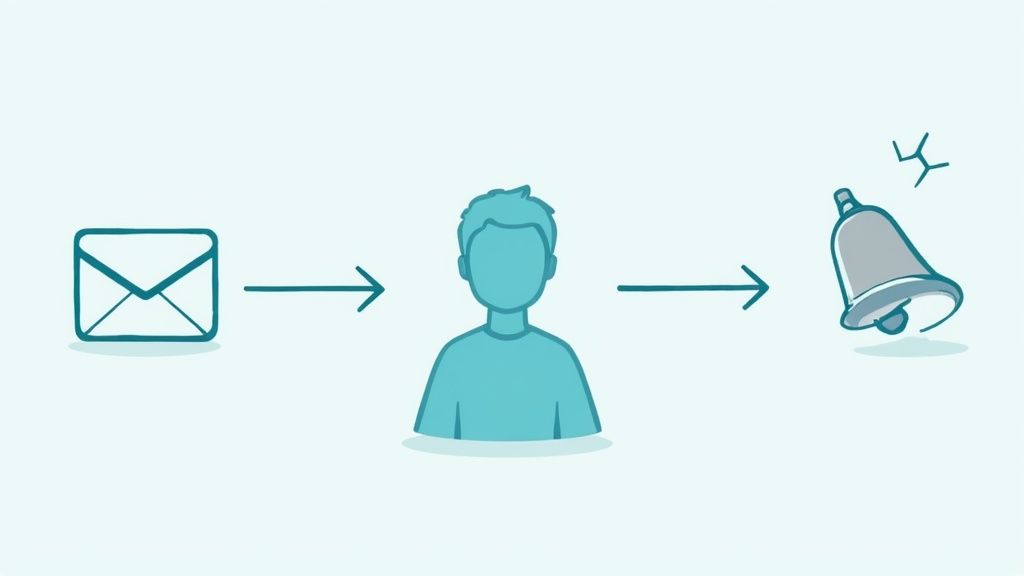
Why It Works and How to Implement It
Triggered messages cut through the noise because they’re a direct response to a user's interest, resulting in sky-high engagement. Amazon’s legendary abandoned cart emails, which recover nearly 30% of lost sales, are a prime example of this strategy in action. By automating a reminder based on user behavior (adding to cart but not buying), they created a simple yet massively effective revenue-generating machine.
Ready to set your own triggers?
- Map Key Touchpoints: Before building any automations, map out your ideal user journey. Identify critical moments like signing up for a waitlist, connecting a wallet, or making their first swap. These are your trigger points.
- Use Progressive Delays: Don't bombard users. If someone visits your pricing page, wait an hour or two before sending a follow-up quest about your features. This feels helpful, not creepy.
- Combine Behaviors: Create more sophisticated triggers by combining actions. For example, target users who have both joined your Discord and visited your "How to Stake" guide for a hyper-relevant staking quest.
- Test Trigger Sensitivity: Find the sweet spot. Is a single page visit enough to trigger a message, or should you wait for three? A/B test your thresholds to see what drives the best engagement without annoying your community.
Platforms like ActiveCampaign have built their entire model around this concept, allowing for incredibly granular behavioral automation. You can explore ActiveCampaign's trigger options to get ideas for your own Web3 project.
4. Multi-Channel Campaign Integration
Your users don't live on a single platform, so your marketing shouldn't either. Multi-channel campaign integration is the practice of creating a seamless, unified experience across all the places your community hangs out, whether it's email, Discord, X (formerly Twitter), or your dApp. It’s about ensuring your message is consistent and your users can switch channels without losing context.
Think of it like a cross-chain protocol for your marketing. A user might discover your new quest on X, click a link that takes them to your web app to connect their wallet, and then get a confirmation in your Discord. Each touchpoint feels connected, creating a cohesive journey rather than a series of disjointed interactions. This is a core marketing automation best practice for building a strong, engaged community.
Why It Works and How to Implement It
This approach meets users where they are, boosting engagement and making your brand feel omnipresent. Disney’s MagicBand is a masterclass in this, linking park experiences, payments, and digital memories into one unified system. A cohesive strategy prevents message fatigue and ensures your brand story is told consistently everywhere.
Ready to connect your channels?
- Start Small: Don't try to be everywhere at once. Pick 2-3 core channels where your audience is most active (like X, Discord, and your blog) and perfect the integration before expanding.
- Centralize Your Data: Use a Customer Data Platform (CDP) or a similar tool to create a single source of truth for user data. This allows you to track a user’s journey across different platforms.
- Maintain a Consistent Voice: Your brand should sound the same whether you're sending an email, posting a meme, or writing an announcement. Create simple brand voice guidelines for your team to follow.
- Map the User Journey: Visualize how users will move between channels. What action on one platform triggers a message on another? For example, completing an on-chain quest could trigger a celebratory shout-out on X.
Platforms like Salesforce Marketing Cloud have been pioneers in this space, helping brands orchestrate complex cross-channel campaigns. To see how these principles apply directly to Web3 spaces, you can learn more about community engagement best practices and how to create a truly connected experience.
5. A/B Testing and Continuous Optimization
Guesswork is the enemy of growth. A/B testing and continuous optimization are the systematic ways you eliminate it from your strategy, making it one of the most critical marketing automation best practices. Instead of launching a quest and just hoping it works, you test different versions of your emails, landing pages, and workflows to see what truly resonates with your community. It’s the difference between throwing spaghetti at the wall and scientifically engineering the perfect pasta dish.
This approach is about making small, incremental changes based on real data. You're not just looking for a one-time win; you're building a system of constant improvement that refines your automated campaigns over time. Think of how Netflix relentlessly tests thumbnail images to boost viewership; the same data-driven mindset can supercharge your Web3 quests.
The infographic below illustrates the simple yet powerful process flow for an effective A/B test.
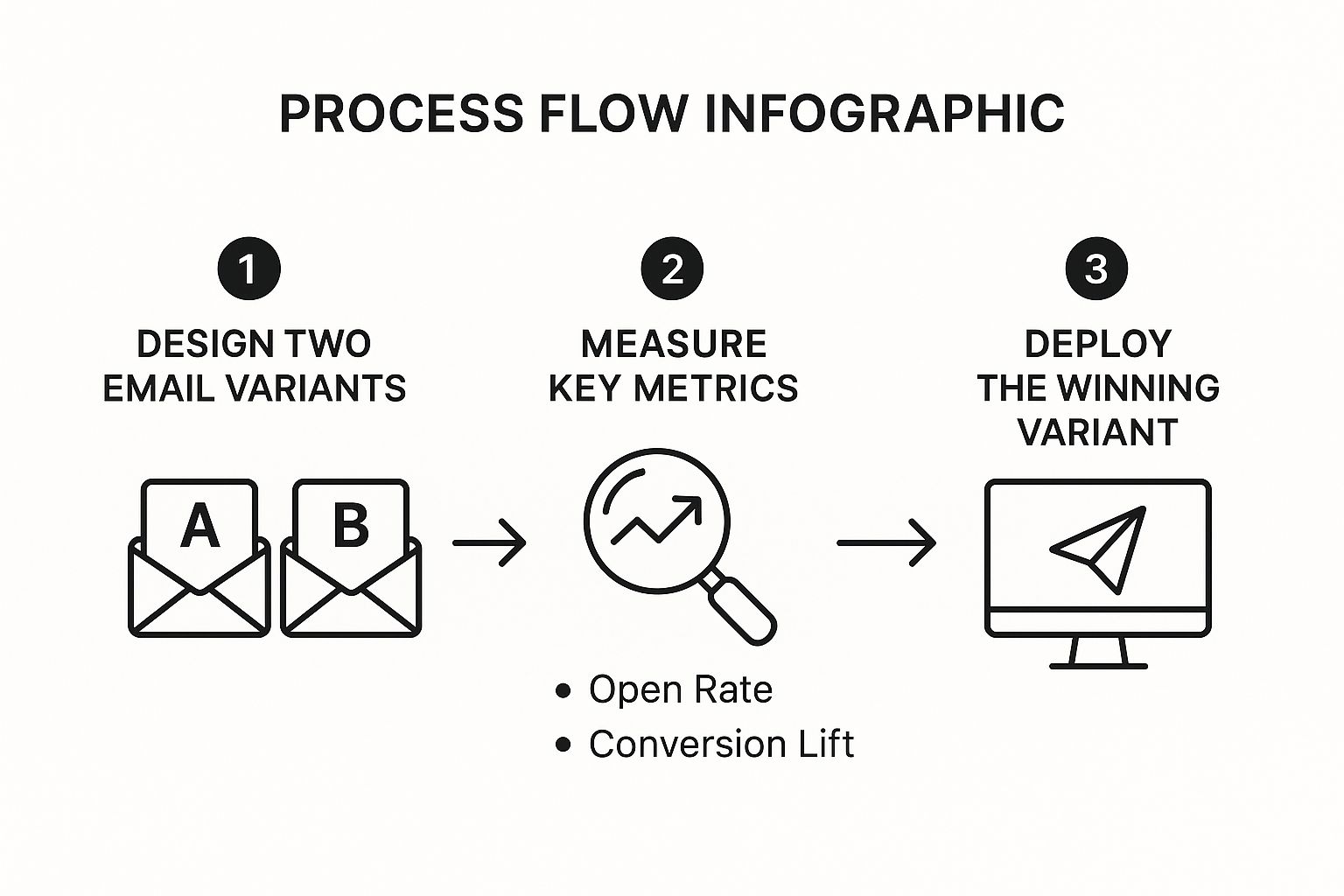
By following this disciplined cycle of creating variants, measuring performance, and deploying the winner, you ensure your campaigns are always evolving.
Why It Works and How to Implement It
A/B testing provides concrete proof of what works, removing ego and assumptions from your marketing decisions. It’s a practice popularized by tech giants like Google and platforms like Optimizely, which helped IBM achieve a 67% conversion lift through systematic testing. This data-driven approach ensures your automation efforts become more effective and efficient over time.
Ready to start optimizing?
- Test One Variable: To get clear results, change only one thing at a time. Test a subject line, a call-to-action, or the quest reward, but not all at once.
- Run for a Sufficient Period: Let your test run long enough to gather statistically significant data. A one-day test might not account for weekly engagement patterns.
- Focus on High-Impact Elements: Start by testing elements that have the biggest potential impact on your goals, like the headline of your quest announcement email or the primary button on a landing page.
- Document Everything: Keep a log of your tests, hypotheses, and results. This knowledge base becomes invaluable for planning future campaigns and avoiding past mistakes.
Platforms like VWO and HubSpot make setting up and analyzing tests straightforward. By integrating A/B testing into your workflow, you turn your marketing automation into a powerful learning engine that constantly adapts to your audience.
6. Customer Journey Mapping and Workflow Design
You can't automate a path you don't understand. Customer journey mapping is about visualizing every single touchpoint a user has with your project, from first hearing about your airdrop to becoming a DAO governance whale. It’s the blueprint for your entire engagement strategy. Workflow design then takes this map and builds the automated marketing sequences that guide users along the optimal path.
Think of it as designing a multi-level video game. The journey map is the world map showing all possible routes, side quests, and boss battles. The workflow is the code that triggers specific events, like giving a player a power-up (sending a discount) when they defeat a mini-boss (completing a quest).
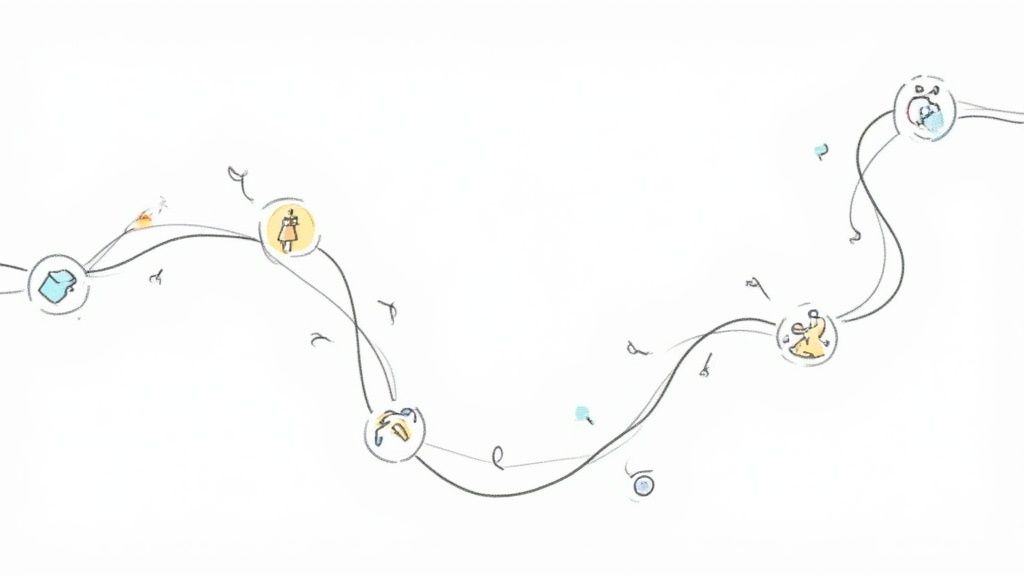
Why It Works and How to Implement It
This strategic approach prevents disjointed user experiences and ensures every automated message feels timely and relevant, not random. By understanding the user's perspective, you can proactively address their needs and guide them toward conversion. For example, Salesforce's journey mapping famously helped T-Mobile slash customer churn by 50% by identifying and fixing friction points. This is a core component of successful marketing automation best practices.
Ready to map your own journey?
- Start with Data, Not Guesses: Use actual user data from your analytics, community chats, and support tickets. Don't assume you know what users are doing.
- Involve the Whole Crew: Bring in your community mods, devs, and support team. They have direct insight into user pain points and motivations that marketers might miss.
- Focus on High-Value Segments: Don't try to map every possible user at once. Start with your most valuable persona, like "High-Volume NFT Traders," and build from there.
- Build in Off-Ramps: Not every user will follow the golden path. Your workflows need exit points and alternative routes for users who disengage or show different interests.
For a practical understanding of how these processes are structured, exploring platforms with dashboards for managing marketing automation workflows can reveal how these maps translate into real-world automated sequences.
7. Data Quality Management and Hygiene
Garbage in, garbage out. This classic data science mantra is the heart of data quality management, a critical but often overlooked marketing automation best practice. It’s all about ensuring the information fueling your automated quests and campaigns is accurate, complete, and up-to-date. Without clean data, your carefully crafted segments and personalized messages will miss the mark entirely.
Data hygiene is the ongoing process of keeping that information pristine. It involves regularly cleaning, deduplicating, and validating your user data. Think of it as spring cleaning for your community database: you're clearing out the inactive wallets, merging duplicate profiles, and ensuring every ENS name points to the right user. This prevents you from rewarding the same user twice or sending airdrops to dead addresses.
Why It Works and How to Implement It
Clean data leads to higher engagement, better personalization, and a more accurate understanding of your community’s behavior. For instance, ZoomInfo's data enrichment tools have been shown to help companies improve their lead quality by up to 40% simply by providing accurate, verified information. This directly translates to more effective targeting and higher conversion rates.
Ready to scrub your database clean?
- Validate at the Source: Implement data validation rules right at the point of entry. If a user is connecting their wallet or signing up for a quest, ensure the information provided meets your standards before it ever enters your system.
- Regular Audits are Key: Schedule monthly or quarterly data audits. Use tools to scrub your email lists, remove inactive users, and identify profiles with incomplete data.
- Use Progressive Profiling: Don’t ask for everything at once. Gradually collect more data as users engage with more quests. This fills in data gaps over time without overwhelming new community members.
- Implement Access Controls: Not everyone on the team needs full access to user data. Use role-based access controls to prevent accidental changes or deletions, protecting the integrity of your information.
8. Personalization at Scale
Don't just automate messages; automate relevance. Personalization at scale moves beyond just using a {first_name} tag in an email. It’s about leveraging user data and behavior to deliver unique, one-to-one experiences to a massive audience, making each user feel like your most important community member. This is a core pillar of modern marketing automation best practices.
Think of how Spotify crafts a unique "Discover Weekly" playlist for millions of users or how Amazon’s recommendation engine drives a staggering 35% of its revenue. They aren't hand-picking items; they're using automated systems to analyze data and predict what you'll love next. In Web3, this could mean offering a quest to a user based on the specific NFTs they hold or the DeFi protocols they’ve interacted with.
Why It Works and How to Implement It
This hyper-targeted approach makes users feel seen and understood, dramatically boosting engagement and loyalty. It turns a generic broadcast into a meaningful conversation, which is critical for building a strong community. Coca-Cola's "Share a Coke" campaign, which personalized bottles with common names, is a classic example of how even simple personalization can create a massive cultural impact.
Ready to scale your personalization efforts?
- Start with Basic Attributes: Begin by personalizing content based on simple data points you already have, like the user's location, the quest they last completed, or their role in your Discord.
- Use Dynamic Content: Create modular content libraries. Your automation platform can then dynamically assemble unique emails or in-app messages for each user, pulling in relevant quest offers, content, or rewards.
- Leverage AI for Insights: Use AI and machine learning tools to analyze user behavior at scale. These systems can identify hidden patterns and segments you might miss, unlocking new opportunities for hyper-personalization.
- A/B Test Everything: Always test your personalized campaigns against a generic control version. This will prove the ROI of your efforts and help you refine your strategy based on what actually works.
9. ROI Measurement and Attribution Modeling
Launching automated quests without tracking ROI is like sending your community on a treasure hunt with no map. ROI measurement and attribution modeling are critical marketing automation best practices that connect your efforts directly to results. This means moving beyond vanity metrics like quest completions and tracking the actual financial impact of your campaigns, accurately crediting conversions to the specific touchpoints that drove them.
This process helps you understand which automated workflows are actually moving the needle. Are your "Welcome" quests turning new members into active token holders? Is your "Re-engagement" campaign bringing lapsed users back to spend in your dApp? By attributing value correctly, you can prove the worth of your automation strategy and make data-backed decisions instead of just guessing what works.
Why It Works and How to Implement It
This practice ensures you're allocating your budget and resources effectively, doubling down on what generates real value and cutting what doesn't. For instance, using tools like HubSpot’s revenue attribution reporting, marketers can see exactly which email in a nurturing sequence led to a high-value purchase, allowing them to optimize the entire workflow for maximum impact. It’s about making every automated action accountable.
Ready to connect your campaigns to your bottom line?
- Establish Baselines: Before you launch a new automated quest line, know your starting point. What’s your current user acquisition cost or average user lifetime value? This gives you a benchmark to measure against.
- Use Multi-Touch Models: Don't just give all the credit to the final click. Use multi-touch attribution (like data-driven models in Google Analytics 4) to understand how different automated interactions contributed to the final conversion.
- Track Micro-Conversions: Alongside revenue, track key engagement metrics like Discord role upgrades, social media follows, or content downloads that happen via automation. These are strong indicators of future value.
- Audit Your Models: Regularly review your attribution setup to ensure it’s accurately capturing user journeys. As your community and platform evolve, your tracking methods should, too.
Measuring the impact of your automated efforts is crucial for sustainable growth. If you want to get granular on what to track, you can explore more about measuring community engagement to build a comprehensive framework.
Marketing Automation Best Practices Comparison
| Method | Implementation Complexity | Resource Requirements | Expected Outcomes | Ideal Use Cases | Key Advantages |
|---|---|---|---|---|---|
| Lead Scoring and Segmentation | High - requires setup & ongoing tuning | Significant data collection & CRM integration | Focused sales efforts, higher conversion rates | Prioritizing leads, targeted marketing | Improves sales efficiency, personalization |
| Drip Campaign Optimization | Moderate - content creation & monitoring | Content strategy & automation tools | Consistent nurture, improved engagement | Lead nurturing, customer retention | Scales personalization, improves lifetime value |
| Behavioral Trigger Automation | High - complex triggers & real-time tracking | Robust tracking systems & integrations | Timely, relevant messaging, higher conversions | Real-time engagement, peak interest moments | Automates complex scenarios, increases engagement |
| Multi-Channel Campaign Integration | Very High - cross-platform sync | High technical and team resources | Broader reach, cohesive messaging | Omnichannel marketing, brand consistency | Increases engagement, unified customer view |
| A/B Testing and Continuous Optimization | Moderate-High - testing setup & analysis | Traffic volume & analytic expertise | Data-driven improvements, higher ROI | Campaign optimization, decision making | Reduces guesswork, enables continuous improvement |
| Customer Journey Mapping and Workflow Design | High - research & cross-team collaboration | Time and team coordination | Optimized customer paths, better conversion | Complex customer journeys, workflow automation | Identifies gaps, improves experience |
| Data Quality Management and Hygiene | Moderate - ongoing cleaning & validation | Data tools & monitoring resources | Improved data accuracy, better targeting | Database maintenance, campaign accuracy | Enhances deliverability, reduces waste |
| Personalization at Scale | High - technical & content complexity | Extensive data & content creation | Increased engagement and customer loyalty | Large audience personalized marketing | Efficient mass customization, competitive edge |
| ROI Measurement and Attribution Modeling | High - technical integration & modeling | Expert analytics & multiple data sources | Clear ROI insights, optimized budget | Budget allocation, performance tracking | Data-driven decisions, performance insight |
Start Automating, Start Growing
You've made it through the core principles of modern marketing automation, and hopefully, you're buzzing with ideas. We've journeyed through the essentials, from the strategic power of lead scoring and segmentation to the nuts and bolts of data hygiene and A/B testing. The overarching theme is clear: success isn't about flipping a switch and hoping for the best. It's about building a smart, responsive, and data-driven engine that nurtures your community and drives sustainable growth.
The Web3 space moves at a breakneck pace, and manual, one-off marketing efforts simply can't keep up. The real competitive advantage lies in implementing these marketing automation best practices to create systems that work for you 24/7. Think of it as building an automated community manager that can personally welcome new members, guide them through their first on-chain actions, and reward them for their loyalty, all without you lifting a finger for each individual interaction.
Key Takeaways for Your Web3 Strategy
Let's distill this down to the most critical takeaways. Your focus should be on:
- Behavior Over Demographics: Stop guessing what your audience wants. Use behavioral triggers to react to what they actually do on-chain and in your dApp.
- The Journey is Everything: Don't just automate random tasks. Map your ideal user journey from discovery to evangelism and build automated workflows that guide them seamlessly along that path.
- Personalization Wins: Use the rich data available in Web3 to deliver experiences that feel one-to-one, not one-to-many. A quest tailored to a user's past NFT mints is infinitely more powerful than a generic airdrop announcement.
Your Actionable Next Steps
Feeling inspired but a bit overwhelmed? Don't be. The key is to start small and build momentum. To truly understand the benefits discussed here and how to 'Start Automating, Start Growing', it's helpful to first grasp the fundamental concept of What Is Marketing Automation. Once you have that foundation, pick one high-impact area from this list to tackle first.
Maybe it's setting up a simple welcome drip campaign for new Discord members that guides them to connect their wallet. Or perhaps it’s creating a quest that automatically rewards users for making their first swap on your DEX. The goal is to get a quick win, prove the value, and then expand from there.
Mastering these marketing automation best practices is your key to unlocking scalable, efficient, and authentic community engagement. It’s how you move from just acquiring users to building a thriving, self-sustaining ecosystem. The tools are here, the strategies are clear, and the opportunity is massive. Now it's time to build.
Ready to put these best practices into action without writing a single line of code? Domino is a no-code platform built for Web3 growth teams to design, automate, and scale reward-based quests that drive real on-chain results. Start building your first automated quest with Domino today!
Level Up Your dApps
Start using Domino in minutes. Use automations created by the others or build your own.
